ca. 40,000+
up to 350 lbs
Up to 70+ Inches
August-March
Spot and Stalk
Rifle, Archery
ca. 7 Days
Heated Buildings, Beds, and Running Water & Tented Spike Camps
Low to High (tailored to hunter, varies by location)
* Information may vary. Please refer to our terms and conditions page and/or call for the latest details on prices and conditions.
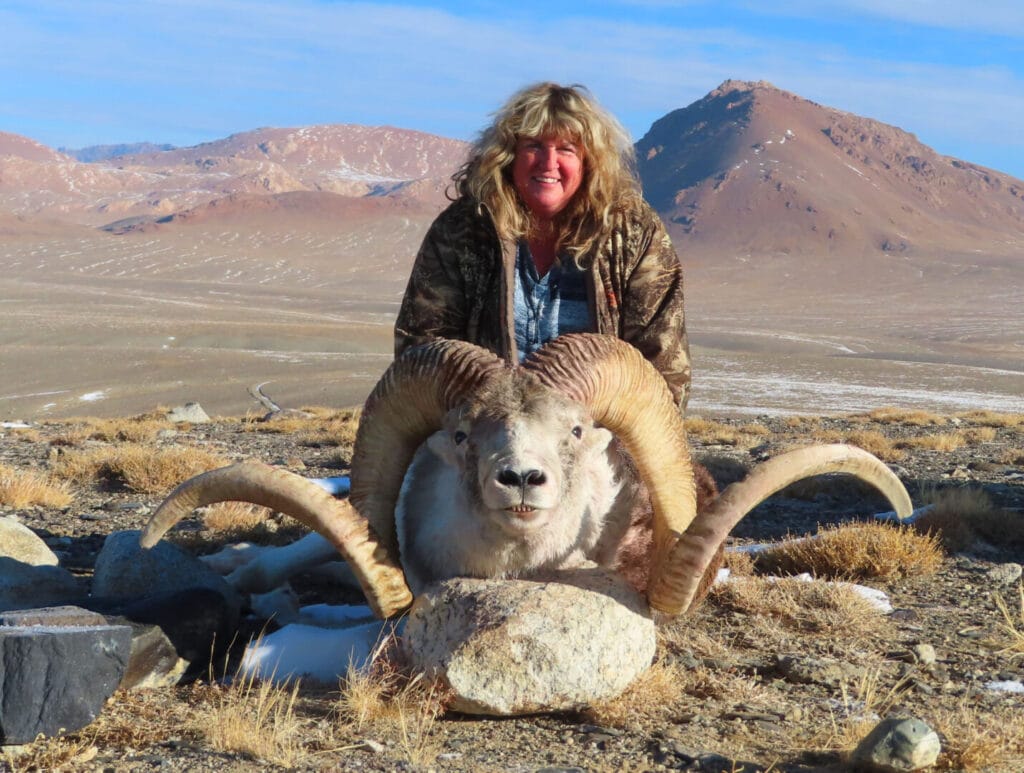
Marco Polo Sheep (Ovis ammon polii) are a high-altitude subspecies of argali (giant sheep species) native to the Pamir and Tian Shan regions of Central Asia, primarily located in Tajikistan, Kyrgyzstan, Afghanistan, and China. Distinguished by exceptionally long, open-spiral horns, they inhabit open basins and plateaus in Tajikistan and Kyrgyzstan, precisely the landscapes that make Marco Polo Sheep hunting a glass-and-stalk pursuit.
Guided and vehicle-assisted: we glass from 4×4s, then make a foot stalk. Typical shots are 400–600+ yards; the farther the shot, the harder precise trophy judging becomes. Fitness varies by country: Tajikistan — Medium; Kyrgyzstan — High.
Prime time is October – December (rut mid-November to early December).
Tajikistan is the premier destination, producing the largest rams and exceptional animal visibility. Kyrgyzstan offers a more affordable option with classic Tien Shan mountain hunting and strong results. We operate in both countries.
Every group is met and escorted on arrival by our senior manager in Tajikistan, Eldar Shafiev, who greets you in Dushanbe and oversees the operation from start to finish for a consistent, reliable experience.
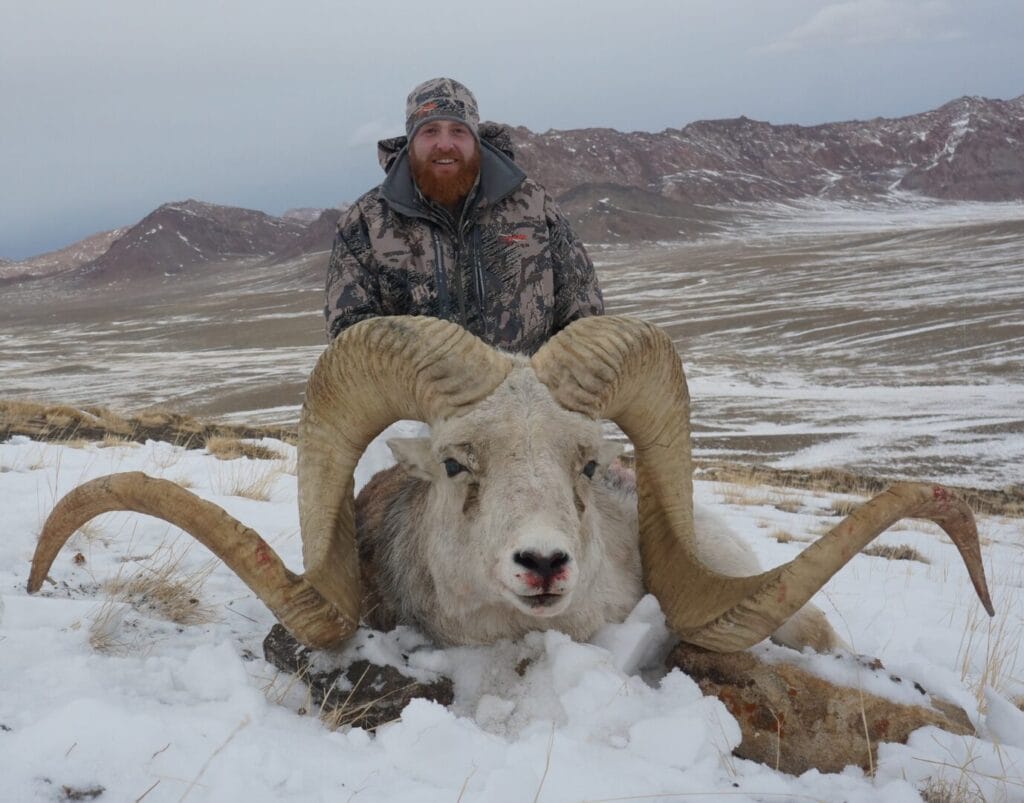
Marco Polo Sheep are the longest-horned wild sheep on earth. Their sweeping, open-spiral horns and striking white cape make them the signature Asian mountain trophy. For many collectors, Marco Polo Sheep hunting is the pinnacle—an iconic, once-in-a-lifetime addition to an OVIS World Slam or international sheep portfolio.
This is authentic high-country hunting without requiring extreme mountaineering. We glass from vehicles to locate rams and then execute a controlled stalk. Shots are typically 400–600+ yards; the farther the shot, the more difficult precise trophy judging becomes—adding a technical marksmanship challenge while keeping the overall Fitness Level: Tajikistan = Medium; Kyrgyzstan = High.
Tajikistan is the best destination overall: the highest trophy ceiling and extraordinary visibility—often observing vast herds across open basins. Kyrgyzstan offers a more affordable path with classic Tien Shan terrain and strong results. We operate in both countries to match budget, style, and goals.
Hunting in these regions supports community livelihoods, incentivizes anti-poaching, and funds science-based wildlife management for argali across the Pamir and Tian Shan ranges. Booking with a reputable operator ensures your hunt contributes to long-term habitat protection and sustainable quotas.

Founded in 1985 and guiding Marco Polo Sheep hunting since 1987, we helped open modern access to the Pamir – Tien Shan and set the operating standards many still follow today. That continuity—four decades of planning, scouting, and execution—underpins the smooth logistics and consistent results our clients expect.
Our record is built on scale and specialization: 1,000+ successful Marco Polo Sheep hunts conducted since 1987. We focus on proven concessions with exceptional visibility, pairing long-range glassing from vehicles with measured foot stalks so hunters can evaluate more rams and make confident decisions.
We contribute to the science and best practices that sustain these hunts, including participation in events such as the Marco Polo Sheep Workshop (Dushanbe). Knowledge-sharing with biologists, NGOs, and operators helps align field methods with conservation and quota management.
Every group is met and escorted on arrival by our senior manager in Tajikistan, ensuring a consistent VIP entry, permits handled, and cohesive daily operations in the mountains. Dedicated guide teams and vehicles support each hunter from first glass to final photo.
Our office, located just outside the United States Fish and Wildlife Service headquarters (Falls Church, Virginia), in Berryville, Virginia, provides clear guidance on documentation and import procedures for Marco Polo trophies. For details, see: Marco Polo Sheep Imports.
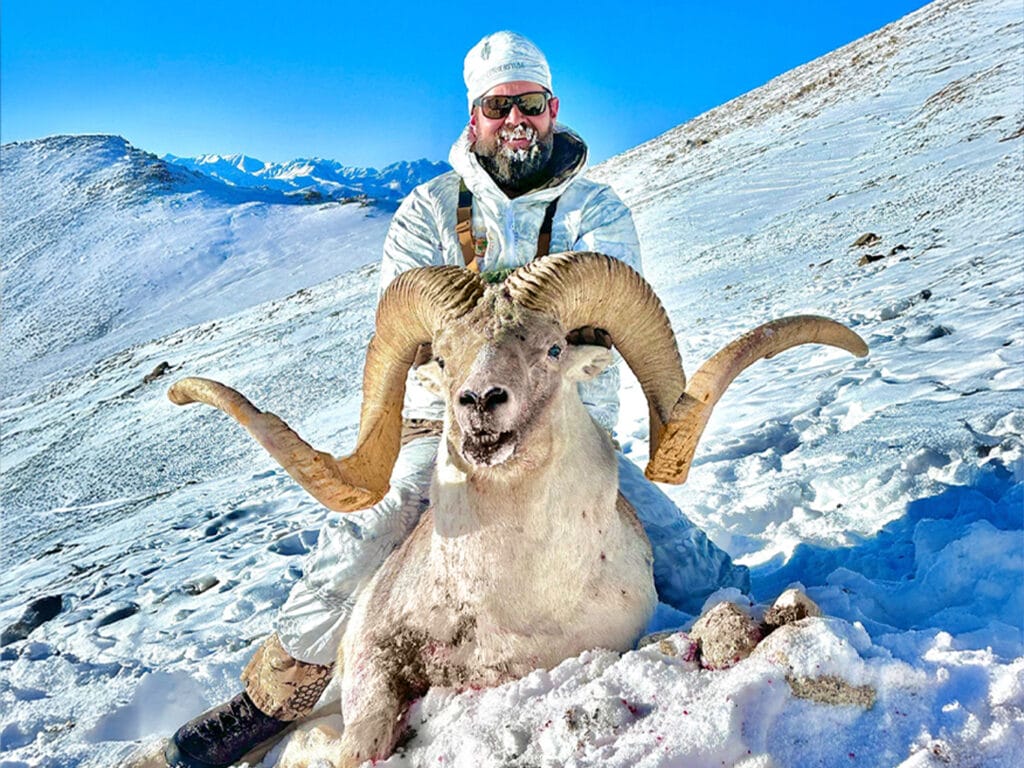
The benchmark for Marco Polo Sheep hunting is the high, open plateaus of the Eastern Pamirs. Vast basins and rolling ridges allow long-distance glassing straight from 4×4 vehicles, then a measured foot stalk to position for a shot. Visibility is exceptional here—clients routinely observe over 1,000 sheep each hunting day—making Tajikistan the best destination for top-end rams. Typical shot distances are 400–600+ yards; longer shots are possible, and the farther the shot, the more care we take with trophy judging. Fitness Level: Medium. Approximate hunt elevation ranges from ~12,500–15,500 ft.
Kyrgyzstan offers a more affordable path into Marco Polo Sheep hunting across classic Tien Shan country—glaciated peaks, broad benches, and high alpine bowls. Access blends vehicles for reach with horseback and on-foot movement in many concessions. Expect open-country glassing and controlled stalks, with shot opportunities commonly in the 400–600+ yard band. Trophy expectations are strong, though the overall ceiling is typically lower than Tajikistan. Fitness Level: High (horseback and on-foot at elevation).
Each hunter is supported by a dedicated guide team and vehicle for efficient glassing and safe, measured stalks. Every group is met and escorted on arrival by our senior manager in Tajikistan, Eldar Shafiev, who oversees VIP entry, permitting, travel coordination, and camp operations for a consistent, reliable experience. This structure lets our professional hunters focus on selective evaluation and ethical shot setup—particularly important at long range where judging is more difficult.
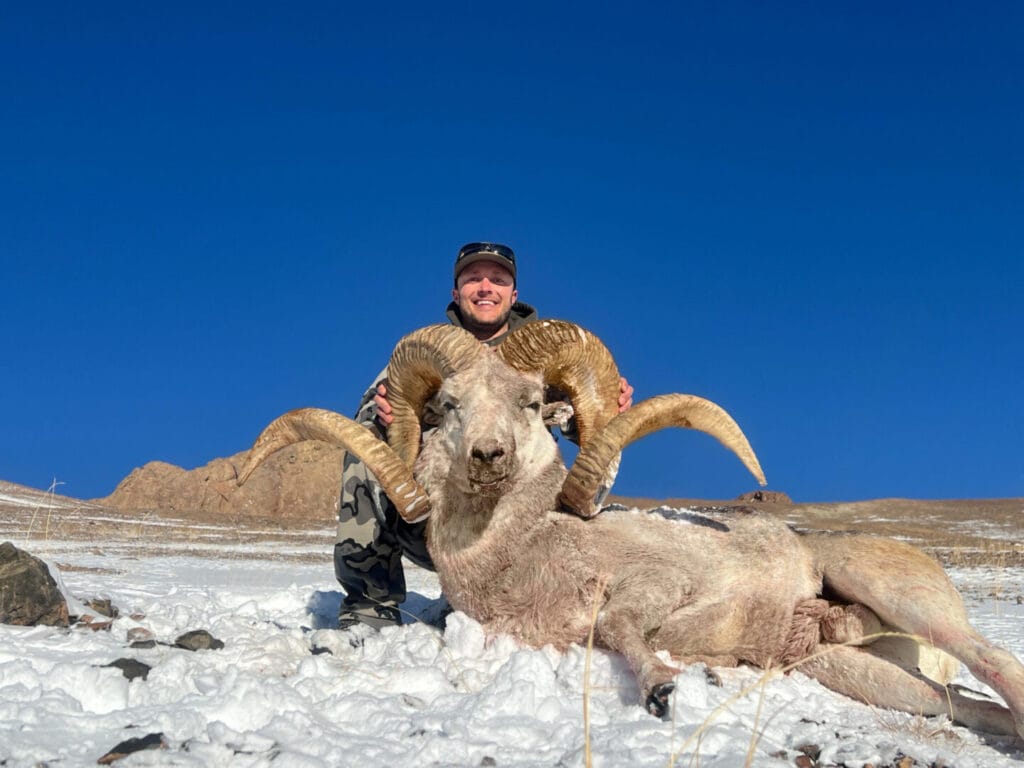
Marco Polo Sheep belong to the argali complex (Ovis ammon), assessed as Near Threatened globally. Argali are listed under international frameworks that regulate trade and cooperation across borders—most notably the IUCN Red List assessment, CITES (international trade controls), and the Convention on Migratory Species (CMS) Appendix II for transboundary management.
In Tajikistan’s Eastern Pamirs—where our flagship hunts occur—independent winter vehicle surveys have recorded large numbers of Marco Polo sheep across broad basins, reflecting strong local abundance. These densities underpin the exceptional visibility hunters experience during the prime season.
Hunting is regulated by annual, government-issued quotas. For U.S. hunters, argali trophies from Tajikistan, Kyrgyzstan, and Mongolia are importable by permit; compliance includes demonstrating the trophy was taken under the range country’s quota and meeting all documentation requirements. We guide clients through this process end-to-end.
Across the Pamirs, community/family-based conservancies, research partners, and NGOs have contributed to monitoring, anti-poaching, and habitat management. This model links local livelihoods to healthy wildlife, helping sustain argali and their habitats when well-managed under transparent quota systems.
When you book with a compliant, conservation-minded operator, your hunt supports regulated harvest, on-the-ground monitoring, and community incentives—all of which reinforce long-term population health for Marco Polo Sheep in the Pamir–Tien Shan region.
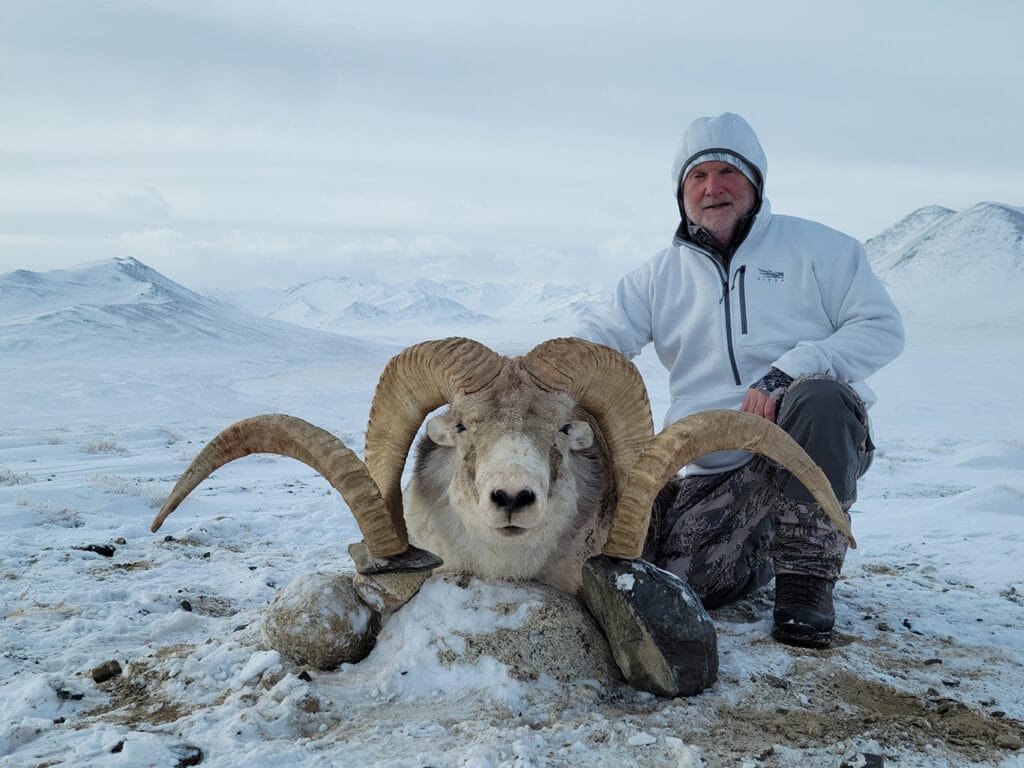
These are classic glass-and-stalk mountain hunts using both vehicles and, in Kyrgyzstan, horses. In Tajikistan’s Eastern Pamirs we reach dominant vantage points by 4×4, glass from the vehicle to sort rams, then make a measured foot stalk. In Kyrgyzstan’s Tien Shan we combine 4×4 access with horseback to cover country efficiently and reach remote basins; rifles ride in a scabbard and we always dismount to stalk and shoot on foot. Field days typically run from just before dawn until dark, with the pace set by wind, light, and animal movement—true Marco Polo Sheep hunting rhythm.
Tajikistan is high, open country—broad plateaus, wide basins, and rolling ridges that favor long, efficient glassing. Hunts commonly unfold between about 12,500–15,500 ft, and late-fall conditions are often windy and cold. Kyrgyzstan’s Tien Shan is steeper and more segmented, with glaciated peaks and big benches; horseback extends your range but introduces more time in the saddle and short climbs from tie-offs. In both countries, plan layers around wind chill at altitude and expect fast weather shifts.
Typical shot opportunities are 400–600+ yards. Longer distances are possible depending on terrain and the hunter’s condition, but we only take them when the evaluation is crystal clear. The farther the shot, the harder precise trophy judging becomes, so your team manages angles, time, and animal position to keep identification unambiguous. Bring a rifle you truly know, a rangefinder with ballistic data, and a simple dope card; we’ll build a stable position without rushing.
Remote base camps sit around ~13,600 ft and are configured for comfort and safety: heated sleeping quarters, hot showers, flush toilets, generator power, dependable communications (including satellite), a portable hyperbaric chamber, Wi-Fi, Starlink, and hot meals. Every group is met and escorted on arrival by our senior manager in Tajikistan (VIP terminal in Dushanbe), who oversees permits and movements. Overland travel proceeds via a regional town en route to camp; we do not publish specific overnights publicly. This hosted model keeps logistics smooth so the hunt itself remains the focus.
Tajikistan — Fitness Level: Medium. Vehicle-based glassing with deliberate stalks keeps physical demand reasonable at altitude. You’ll walk when it counts, but long, sustained climbs are uncommon in our format.
Kyrgyzstan — Fitness Level: High. Steeper country, saddle time, and on-foot climbs from horse tie-offs increase overall demand. Build aerobic capacity and leg/core strength, and get some pre-trip riding to improve balance and comfort.
The absolute prime window is November–December (rut typically mid-November to early December). In our flagship Tajik areas, hunters routinely glass very large numbers of sheep per day from vehicle-access vantage points before committing to a stalk—one reason selectivity and results are so strong here.
Expect sustained wind and cold. Prioritize layered, windproof clothing; quality optics; a rangefinder with reliable ballistic inputs; and practiced long-range fundamentals. We provide an equipment checklist with your travel packet to streamline packing and rifle setup.
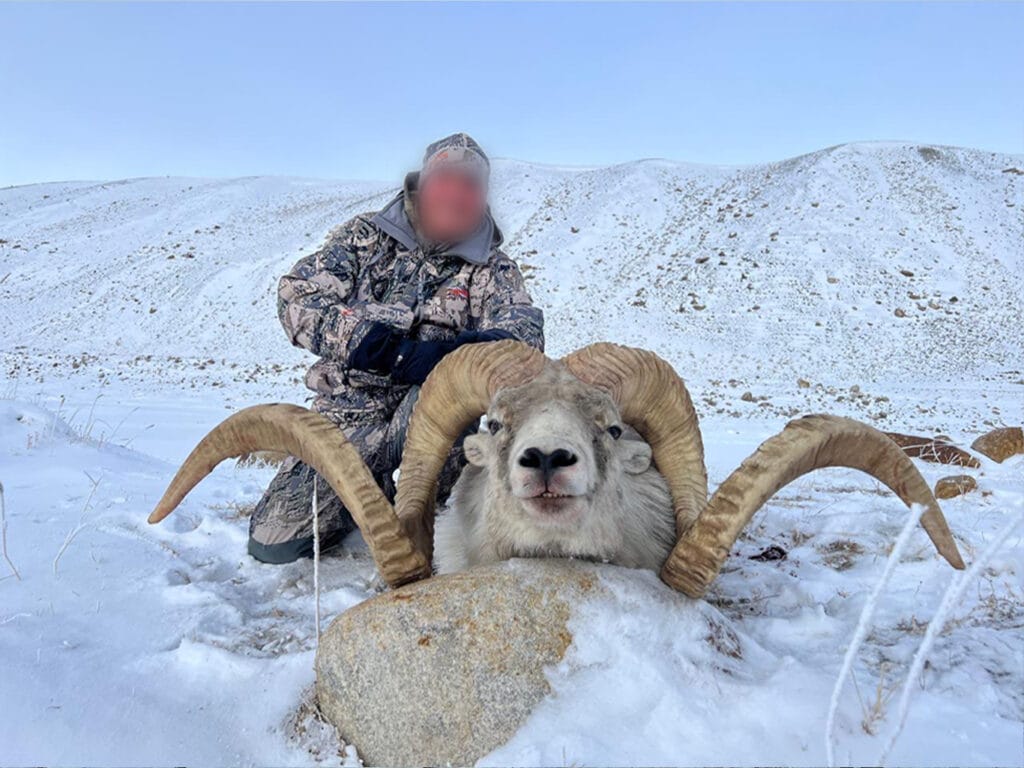
Day 1 — Arrive Dushanbe: VIP arrival and hosted reception. Our program manager greets you in the VIP terminal, expedites entry, confirms permits, and escorts you to a comfortable overnight in Dushanbe.
Day 2 — Transfer to the mountains (en route overnight): Overland drive toward the Pamirs with an overnight in a regional town along the route. Gear check and early acclimatization.
Day 3 — Into base camp: Continue into the high country and settle into camp (~12,000 – 13,500 ft depending on camp). Safety/communications brief, rifle check and zero at altitude, light glassing from nearby vantage points.
Days 4–9 — Hunt Marco Polo Sheep: Vehicle-assisted glassing at first and last light, then measured foot stalks. Expect long sessions behind optics, selective evaluation, and typical shot opportunities in the 400–600+ yard band. As shot distance increases, precise trophy judging becomes more challenging—your guide team manages angles and time to keep identification clear. If your Marco Polo tag is filled early and quotas allow, optional time may be devoted to a planned add-on (e.g., Mid-Asian Pamir ibex).
Day 10 — Final hunt day / contingency: Continue focused hunting or complete add-on plans as conditions allow. Camp celebration and preparation for departure the following morning.
Day 11 — Depart camp to regional town: Overland return to a regional town for an overnight, with hosted logistics throughout.
Day 12 — Return to Dushanbe: Escorted transfer back to the capital; evening at leisure and rest prior to departure.
Day 13 — International departure: Escorted VIP departure assistance in Dushanbe and outbound flight.
Day 1 — Arrive in-country: VIP arrival and escorted transfer to lodging in Bishkek. Final gear review for horseback and high-country travel.
Day 2 — Transfer toward the Tien Shan (en route overnight): Overland drive toward the mountain region with an overnight in a regional town. Briefing on horse handling and rifle carry in a scabbard.
Day 3 — Into base camp: Final approach to camp and orientation ride. Rifle zero at altitude, saddle fit and stirrup adjustments, and short glassing ride to gauge terrain and comfort.
Days 4–9 — Hunt Marco Polo Sheep: Combine 4×4 access with horseback to reach remote basins. Dismount to stalk and shoot on foot. Expect elevation changes, time in the saddle, and typical shot opportunities of 400–600+ yards. Guides stage horses well below the final approach and coach pace, angles, and stability for confident, ethical shots.
Day 10 — Final hunt day / contingency: Continue targeted hunting in priority basins or allocate time to a planned add-on (if quotas and conditions allow). Evening celebration in camp.
Day 11 — Depart camp to regional town: Overland return with an overnight en route, hosted throughout.
Day 12 — Return to the capital region: Hosted transfer, rest and pack for outbound flight.
Day 13 — International departure: Hosted airport assistance and outbound flight.
Prime window: October – December (rut typically mid-November to early December) for the best visibility, mature ram activity, and consistent conditions. We avoid listing exact overnight properties publicly; all logistics are hosted and escorted to keep the experience smooth and secure.
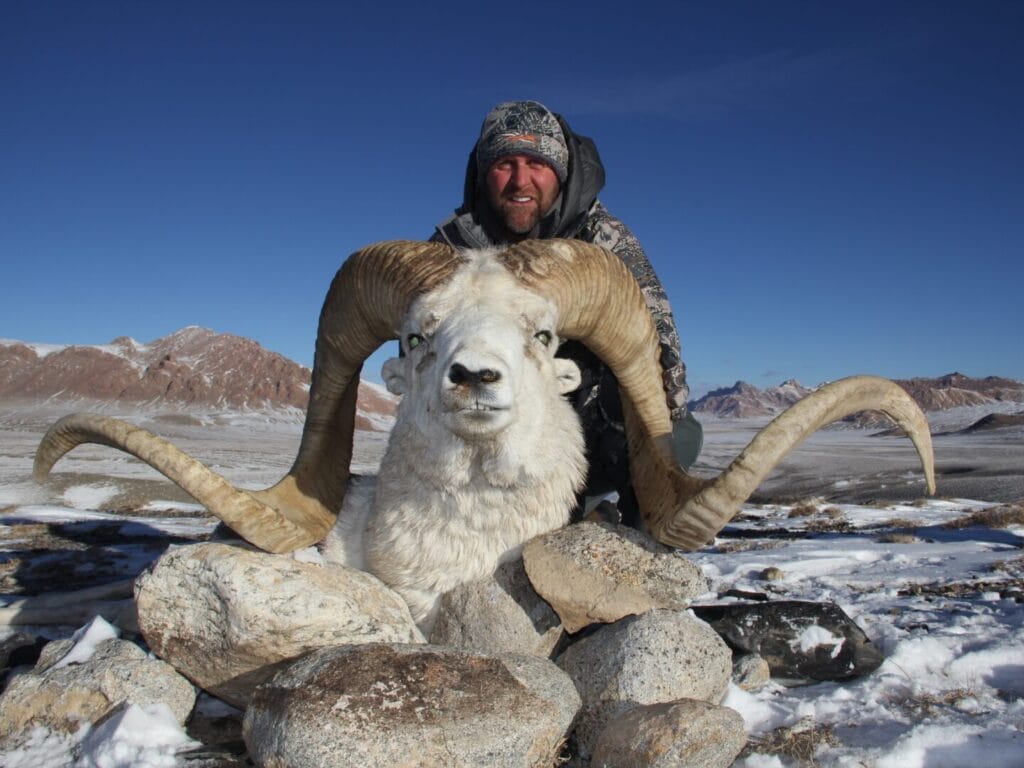
The most efficient companions to Marco Polo Sheep hunting are regional caprids in the Pamir of
Tajikistan and the Tien Shan of
Kyrgyzstan. Pamir ibex integrate seamlessly with the Tajikistan Marco Polo Sheep hunting format (valley driving, short stalks), while Kyrgyzstan’s ibex mirror the higher-effort horseback profile of Tien Shan Marco Polo Sheep hunting.
Ibex add-ons within the sheep area are the most time-efficient. By contrast, Bukharan markhor, Bukharan urial, and some regional ibex options require separate areas from the Marco Polo zones and therefore additional days. We’ll sequence species by quotas, weather, and priorities to maximize field time across Tajikistan and Kyrgyzstan.
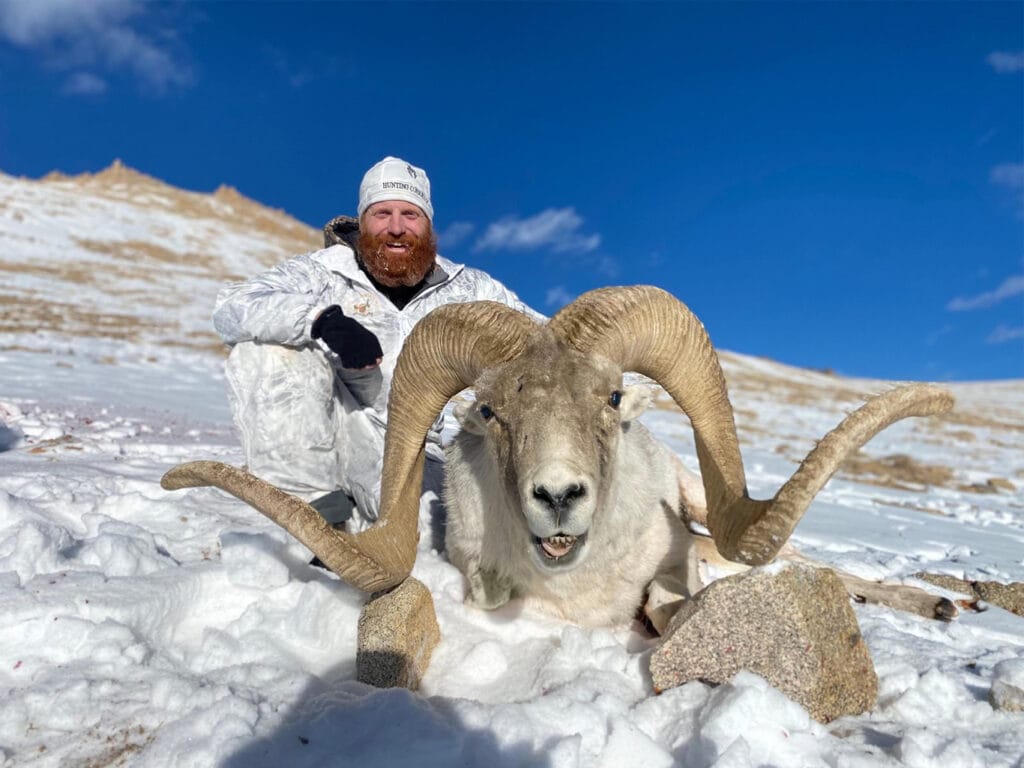
Marco Polo Sheep hunting in Tajikistan unfolds on high, open plateaus and wide basins that favor long, efficient glassing from 4×4 vehicles. We sort rams from vehicle-access vantage points, then make a measured foot stalk to set up a stable shot. Visibility is exceptional here—hunters routinely observe very large numbers of sheep in a single day—so selectivity and learning accelerate quickly. Typical shot opportunities run 400–600+ yards. Fitness Level: Medium due to vehicle-assisted access and deliberate pacing at altitude. Trophy ceiling is the highest in the species’ range, and Mid-Asian Pamir ibex is a time-efficient add-on inside the same valleys.
In Kyrgyzstan, Marco Polo Sheep hunting is a classic alpine program across steeper, more segmented Tien Shan country. We combine 4×4 reach with horseback to access remote bowls and benches, then dismount to stalk and shoot on foot. Expect more elevation change, time in the saddle, and short climbs from horse tie-offs. Shot distances are commonly 400–600+ yards, but the terrain makes evaluation and position-building more technical. Fitness Level: High. Trophy expectations are strong, with the overall ceiling typically lower than Tajikistan; Mid-Asian ibex is an excellent but tougher add-on here.
Pick Tajikistan if your priority is the highest trophy potential, the most efficient glass-and-stalk format, and a Medium fitness demand. Choose Kyrgyzstan for a horseback-forward alpine hunt with a High fitness profile and classic Tien Shan scenery. Either way, we’ll tune your Marco Polo Sheep hunting itinerary—timing, basins, and add-ons—to your goals and the prime season window.
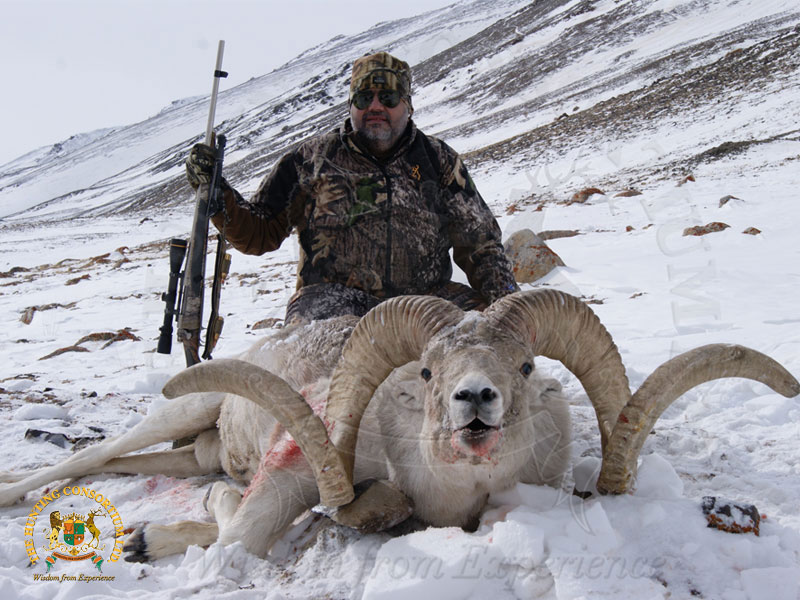
The prime window for Marco Polo Sheep hunting is October to December. The rut typically peaks from mid-November into early December, delivering outstanding visibility and mature ram behavior. Late October can be excellent pre-rut. We do not recommend January–February due to extreme cold and risk in the high country—timing is the single biggest lever for success in Marco Polo Sheep hunting.
Fitness varies by country and access. Tajikistan (Pamir) — Fitness Level: Medium: vehicle-assisted glassing with measured foot stalks at altitude. Kyrgyzstan (Tian Shan) — Fitness Level: High: steeper terrain, more elevation change, and time on horseback with on-foot climbs from tie-offs. We tailor Marco Polo Sheep hunting pace to your condition in both regions.
Plan for 400–600+ yards. As distance increases, precise trophy judging becomes harder, so your guide team manages angles, time, and animal position before you commit. Bring a rifle you know well, a rangefinder with dependable ballistic inputs, and a simple dope card—preparation is everything in Marco Polo Sheep hunting.
These are glass-and-stalk mountain hunts. In Tajikistan we reach dominant vantage points by 4×4, glass from the vehicle, then stalk on foot. In Kyrgyzstan we combine 4×4 reach with horseback to access remote bowls, dismounting to stalk and shoot on foot. Field days run from just before dawn until dark, which is the natural rhythm of Marco Polo Sheep hunting.
Remote base camps (~13,600 ft) are configured for comfort and safety: heated sleeping quarters, hot showers, flush toilets, generator power, dependable communications (including satellite), a portable hyperbaric chamber, Wi-Fi, and hot meals—everything you need to focus on Marco Polo Sheep hunting.
Every group is met and escorted by our senior manager in Tajikistan at the VIP terminal in the capital for a consistent, reliable, full-service arrival. He oversees permits, movements, and coordination so you can concentrate on Marco Polo Sheep hunting. We avoid publishing specific overnight properties publicly.
Yes. Observers are welcome subject to space and logistics. In Tajikistan most glassing is from vehicles; in Kyrgyzstan observers should be comfortable with horseback and altitude. We brief clothing, eyewear, hydration, and movement to keep non-hunters comfortable during Marco Polo Sheep hunting.
Travel with your rifle or discuss alternatives with us. We coordinate local permits and arrival procedures, confirm zero at altitude, and advise on cases and ammunition suited to long-range Marco Polo Sheep hunting. If you prefer not to travel with firearms, contact us well in advance for options.
Entry requirements and border permits change periodically. Our office will advise on current visa guidance and obtain required regional permits as part of your packet. We’ll provide exact instructions and documentation timelines once your Marco Polo Sheep hunting dates are confirmed.
Our Berryville, Virginia office—just outside the United States Fish and Wildlife Service headquarters in Falls Church—provides end-to-end guidance on permits and export paperwork, and coordinates with the appropriate authorities to keep your Marco Polo Sheep hunting import process on track.
Yes. The most time-efficient add-ons are ibex that share similar terrain and tactics: Mid-Asian Pamir ibex in Tajikistan (generally easier, valley glassing) and Mid-Asian ibex in Kyrgyzstan (harder, horseback and steeper terrain). Other options include Matisoni argali, Tian Shan argali, feral yak, and separate-area programs for Bukharan markhor and Bukharan urial as part of extended Marco Polo Sheep hunting plans.
Think wind-first, then cold. Prioritize a dependable layered system (base/mid/shell), windproof outerwear, insulated gloves and hat, quality optics, a rangefinder with ballistic inputs, and a simple shooting mat or rear bag. Well-broken-in boots with ankle support and a streamlined daypack complete the kit for Marco Polo Sheep hunting in the prime season.
We pace the itinerary for acclimatization, monitor hydration and rest, and maintain communications. Camps carry a portable hyperbaric chamber and satellite comms. Your guides manage travel, exposure, and effort—especially in gusty, sub-zero conditions common to peak-window Marco Polo Sheep hunting.
Added to your favorites!